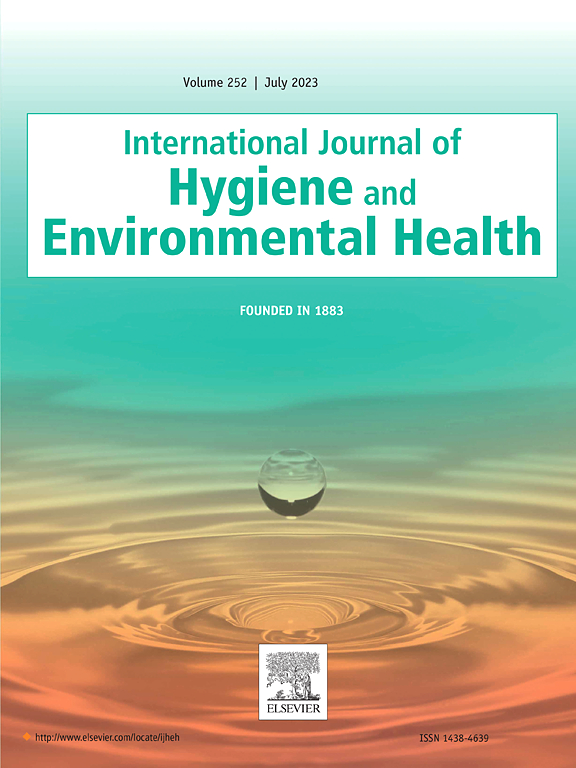How air pollution and extreme temperatures affect emergency hospital admissions due to various respiratory causes in Spain, by age group: A nationwide study
IF 4.4
2区 医学
Q1 INFECTIOUS DISEASES
International journal of hygiene and environmental health
Pub Date : 2025-03-25
DOI:10.1016/j.ijheh.2025.114570
引用次数: 0
Abstract
This study set out to use specifically calculated dose-response functions to analyse how air pollution and extreme temperatures affected short-term daily emergency admissions due to respiratory diseases (asthma, upper respiratory tract infections and pneumonias) in the general population, children under 14 years of age and adults over 65 years of age, in all Spanish provinces across the period January 1, 2013─December 31, 2018. The following independent variables were used: mean daily NO2, PM10, PM2.5 and O3 concentrations recorded at all air pollution monitoring stations situated in the respective provinces; and maximum and minimum daily temperatures measured at reference observatories. Using generalised linear models (GLM) with a Poisson link, and controlling for trend, seasonalities and the autoregressive nature of the series, we calculated the relative risks for statistically significant associations. These were then used to calculate attributable risks and attributable cases, for the purpose of drawing up an economic estimate. Overall, chemical air pollution was linked to 33063 (95 %CI: 13536–55404) respiratory-cause admissions, which accounted for 7.8 % of total admissions in Spain. Respiratory-cause admissions attributable to heat- and cold-wave temperatures totalled 5754 (95 %CI: 2506, 8611), i.e., a lower order of magnitude. Nationwide, the impact of NO2 and O3 was greater than that of PM. The percentage of attributable admissions was higher in the under-14 than in the 65-year age group for all pollutants except ozone. This shows that the implementation of health-prevention plans that included temperature-pollution factors would be an effective way of mitigating the impacts which extreme temperatures and pollution have on population health.
在西班牙,空气污染和极端温度如何影响因各种呼吸道原因而急诊入院的情况,按年龄组分列:一项全国性研究
本研究旨在使用专门计算的剂量反应函数来分析2013年1月1日至2018年12月31日期间西班牙所有省份的空气污染和极端温度如何影响普通人群、14岁以下儿童和65岁以上成年人因呼吸道疾病(哮喘、上呼吸道感染和肺炎)而短期每日急诊入院。使用了以下自变量:各省份所有空气污染监测站记录的日均NO2、PM10、PM2.5和O3浓度;以及参考天文台测得的最高和最低日温度。使用具有泊松关联的广义线性模型(GLM),并控制趋势,季节性和序列的自回归性质,我们计算了统计显著关联的相对风险。然后用这些数据来计算可归因的风险和可归因的病例,以便作出经济估计。总体而言,化学空气污染与33063例(95% CI: 13536-55404)呼吸道原因入院有关,占西班牙总入院人数的7.8%。由热和寒潮温度引起的呼吸系统原因入院总数为5754例(95% CI: 2506, 8611),即较低的数量级。在全国范围内,NO2和O3的影响大于PM。除臭氧外,14岁以下儿童的可归因入院比例高于65岁年龄组。这表明,实施包括温度污染因素在内的健康预防计划将是减轻极端温度和污染对人口健康影响的有效途径。
本文章由计算机程序翻译,如有差异,请以英文原文为准。
求助全文
约1分钟内获得全文
求助全文
来源期刊
CiteScore
11.50
自引率
5.00%
发文量
151
审稿时长
22 days
期刊介绍:
The International Journal of Hygiene and Environmental Health serves as a multidisciplinary forum for original reports on exposure assessment and the reactions to and consequences of human exposure to the biological, chemical, and physical environment. Research reports, short communications, reviews, scientific comments, technical notes, and editorials will be peer-reviewed before acceptance for publication. Priority will be given to articles on epidemiological aspects of environmental toxicology, health risk assessments, susceptible (sub) populations, sanitation and clean water, human biomonitoring, environmental medicine, and public health aspects of exposure-related outcomes.

 求助内容:
求助内容: 应助结果提醒方式:
应助结果提醒方式:


